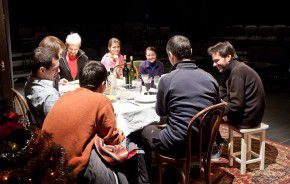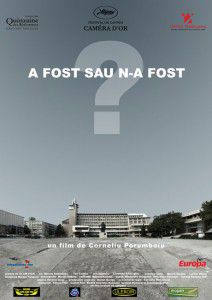By Kerrine Goh
06 Dec 2010
Romanian Cinema, Here and Now

After forty-two years of communism, the 1989 Revolution brought freedom of expression in Romania, but it took more than ten years for filmmakers to fully use it. Film production in the nineties was stagnating, and it was for Cristi Puiu’s 2001 debut feature Stuff and dough to shout out the call for a change. However, the idea of a ”new wave” is not really justified; stylistical similarities like the use of long takes, the lack of non-diegetic music and shooting in real locations are not enough to gather all the big names of Romanian cinema under the same conceptual umbrella. The syntagm is obviously a reference to the French Nouvelle Vague; indeed, a new generation bloomed simultaneously, achieving critical success by bringing ”real life” on screen to express dissatisfactions about society, but the comparison ends here. The critics from Cahiers du cinéma became directors as a cohesive group with the same theoretical mantra, La politique des auteurs, while Puiu, Mungiu and Porumboiu emerged as individuals, independent of each other. Last but not least, the Nouvelle Vague had a certain ammount of timeless bohemian coolness that recent Romanian films elude, often taking a brooding plunge into poverty or effects of a corrupt institutional system. Nevertheless, calling the most appreciated Romanian directors auteurs would not be far-fetched, as they have either written their own scripts or had a significant contribution to them, bringing a personal vision on life and cinema.
Although very different, the festival gemstones that have shined so far share a common feature: they all have a touch of Dogme ’95, using minimalistic means of storytelling. This street-smart attitude was not only a reproach to a stiff manner of filmmaking (many pre-revolutionary narratives were tangled up in metaphors that could escape the narrow-minded censors), but also a triumph of creativity over poor funding. In Romania, the state budget for film is managed by CNC (National Center for Cinema), a dubious institution that favours politically-connected anti-talents. This is why Romanian cinema has a number of skeletons in the closet: ridiculously bad high-budget productions, rarely known abroad. Until the budget repartition system changes, films worth watching are made with sponsorships, private finance or even bank loans.
[caption id="attachment_663" align="alignleft" width="290" caption="(photo courtesy of cinemagia.ro)"]
 [/caption]
[/caption]This year, director Constantin Popescu completed his first feature film, The Portrait of the Fighter as a Young Man, first part of a trilogy about the anti-communist resistance in the fifties, stating that he wanted young people to be able to learn what happened back then by watching a film instead of reading twenty history books. The wreckage that calls itself an educational system is constantly blowing away the interest for study, therefore young people born after the Revolution can only get an impression of communism through media or resentful memories of their older peers. In these conditions, Popescu’s intention underlines an important avatar of cinema: that of a historical memento. However, history works best in cinema when it steps in the background, leaving the spotlight for human drama. The best example was the much talked-about 4 Months, 3 Weeks and 2 Days, that brought Cristian Mungiu a Palme d’Or in 2007: a film about solidarity and friendship in rough times. Corneliu Porumboiu’s 12:08 East of Bucharest (2006) was another example: a talk-show about the Revolution triggers a fiercely humorous view on small-town ambitions and mediocrity. Even so, a large part of the public cannot take the ”film about communism” label off these titles, and those who suffered refuse to watch anything that could reopen old wounds. Undoubtedly, the communist regime left a serious mark on Romanian society; as long as there is still pus pouring out of the pustule that errupted in 1989, films on this theme will keep on being made. Director Andrei Ujică takes it to the extreme: he works directly with the past that others draw inspiration from, creating collage essay films from archive footage, like Videograms of a Revolution (1992) and The Autobiography of Nicolae Ceauşescu (2010).
[caption id="attachment_664" align="alignright" width="290" caption="(photo courtesy of cinemagia.ro)"]
However, not all Romanian films are confined in local history and culture: family is a universal theme. Starting from his shorts The Tube with the Hat (2006) and Alexandra (2007) and culminating in his first feature The Happiest Girl in the World (2009), director Radu Jude’s preoccupation for family relationships leads to touching results. After contributing to most of the ”new wave” films, scriptwriter Răzvan Rădulescu made his debut as a director with First of all, Felicia (2010), a discretely brilliant feature about suffocating bonds.
The seventh art is by nature produced for an audience, thus reaching the great public is essential for any film. Romanian cinema is currently stuck in the ”social realism” zone, and this tendency is here to stay, as student films are often following it (moreover, students are encouraged to write their own scripts; so not many valuable scriptwriter-director collaborations can develop). Critics have already noticed and highlighted the need for an alternative: romantic comedies, thrillers or any other genres; not masterpieces, but public-friendly quality productions that could fill theatres. The great public often associates Romanian cinema with ”heavy” arthouse films that find appreciation in festivals abroad, but never attract box office success in their native country. But who is this great public that we are talking about? After undergoing a regime that used to equalize everything up to the number of TV broadcast hours, now the masses can indulge in a large variety of televised brainwashing. Contests, talk-shows or news programmes are turning politics, joys and tragedies into the lowest forms of entertainment. Apart from the few still standing state cinemas, more and more multiplexes are encouraging popcorn lovers to delve into the latest Hollywood blockbusters. This is what shapes the consumers’ tastes and their visual culture; it is no surprise that slow-paced, historically-charged or complex character-driven dramas are rejected with a bored reflex like ”Not another film about communism!”.
[caption id="attachment_667" align="alignleft" width="290" caption="(photo credits Vlad Plăiaşu)"]
 [/caption]
[/caption]Fortunately, culture enthusiasts have an alternative: more and more events are being organized, providing visibility for local and international productions. In Bucharest, the two most important festivals became young, fresh and urban brands: NexT and Anim’est. Transylvania IFF, the biggest Romanian film festival, is growing with every edition in the city of Cluj and will soon celebrate 10 years of quality selections and highbrow debauchery. From this point of view, the time is now; but as long as Romanian film is not popular among its peers, the glorious buzz associated with it may not have a long lifespan, as the foreign attention can always fly away towards the next exotic destination.
by Andreea Dobre
Andreea is a student from Bucharest who goes to the cinema more often than to school and a member of the cultural NGO Make a Point.
Similar content
posted on
21 Mar 2012
posted on
15 Feb 2011
posted on
20 Jan 2011
posted on
25 Mar 2012
posted on
10 Dec 2010
posted on
25 Jun 2007



